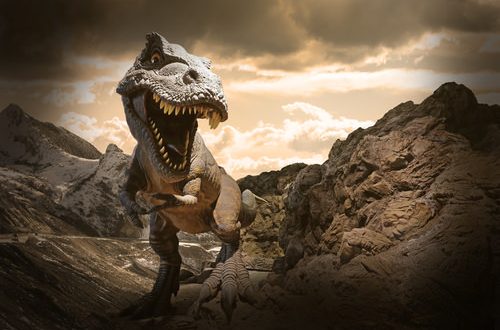Dinosaurs are often depicted in movies as roaring ferociously, but it is likely that some dinosaurs mumbled or cooed with closed mouths, according to a study posted online in the journal Evolution that will be published in the August print issue.
Closed-mouth vocalizations are sounds that are emitted through the skin in the neck area while the beak is kept closed. To make them, birds typically push air that drives sound production into an esophageal pouch rather than exhale through the open beak. The coos of doves are an example of this behavior. Compared with sounds emitted through an open beak, closed-mouth vocalizations are often much quieter and lower in pitch. Birds making closed-mouth vocalizations usually do so only to attract mates or defend their territory. At other times, they emit sounds through an open mouth.
To understand when and how closed-mouth vocalization evolved, researchers with The University of Texas at Austin, Midwestern University in Arizona, Memorial University of Newfoundland and the University of Utah used a statistical approach to analyze the distribution of this vocal ability among birds and other reptilian groups. In total, the researchers identified 52 out of 208 investigated bird species that use closed-mouth vocalization.
“Looking at the distribution of closed-mouth vocalization in birds that are alive today could tell us how dinosaurs vocalized,” said Chad Eliason, a postdoctoral researcher at The University of Texas Jackson School of Geosciences and the study’s co-author. “Our results show that closed-mouth vocalization has evolved at least 16 times in archosaurs, a group that includes birds, dinosaurs and crocodiles. Interestingly, only animals with a relatively large body size (about the size of a dove or larger) use closed-mouth vocalization behavior.”
Tobias Riede, a physiology professor at Midwestern University and the study’s first author, said the association with large bodies is a matter of physics.
“The inflation of an elastic cavity could present a size-dependent challenge,” Riede said. “The lung pressure required to inflate a cavity depends on the tension in the wall of the cavity, and this tension increases for smaller body sizes.”
Researchers still are not certain about how the ancestors of modern archosaurs vocalized. But the occurrence of closed-mouth vocalization across birds and crocodiles — the two surviving groups of archosaurs — indicates that closed-mouth vocalization can emerge in diverse archosaur species depending on behavioral or environmental circumstances, Riede said.
“A cool thing about this work is the demonstration that closed-mouth behavior evolved many times,” Riede said. “That suggests it can emerge fairly easily and be incorporated into mating displays.”
Because dinosaurs are members of the archosaur group, and many had large body sizes, it is likely that some dinosaurs made closed-mouthed vocalizations in a manner similar to birds today, perhaps during mating displays. However, at this point in time, no direct fossil evidence exists to reveal what dinosaurs sounded like.
Julia Clarke, a professor at the Jackson School of Geosciences and co-author, said the study offers clues.
“To make any kind of sense of what nonavian dinosaurs sounded like, we need to understand how living birds vocalize,” she said. “This makes for a very different Jurassic world. Not only were dinosaurs feathered, but they may have had bulging necks and made booming, closed-mouth sounds.”
Agencies/Canadajournal
 Canada Journal – News of the World Articles and videos to bring you the biggest Canadian news stories from across the country every day
Canada Journal – News of the World Articles and videos to bring you the biggest Canadian news stories from across the country every day



